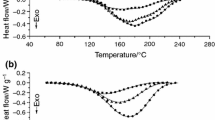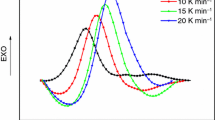Abstract
From the point of view of the chemical reactions describing the curing process of a mixture epoxy resin-dicarboxylic acid anhydride-tertiary amine-polyol and silica filler, it is difficult to understand the network formation: several different reactions are involved, so that the interaction between the epoxy resin and the other components of the mixture is unquestionably complex. However, a linear plot is obtained when Kissinger's method is applied to dynamic DSC results (four different scanning rates), which confirms the calculation assumptions. In particular, the Borchardt and Daniels equation, where the specific rate constant is assumed to be of Arrhenius form appears to be a good mathematical model for describing the curing process under dynamic DSC conditions. The apparent activation energy determined by means of this analytical method is in good agreement with those obtained by other methods in the literature.
Zusammenfassung
Die bei der Härtung eines Epoxidharz, Dicarboxylsäure-Anhydrid, tertiäres Amin, Polyol und einen SiO2-Füllstoff enthaltenden Gemisches vor sich gehende Vernetzung ist schwer zu überblicken; es verlaufen mehrere unterschiedliche Reaktionen, so daß die Wechselwirkung zwischen dem Epoxidharz und den anderen Komponenten außerordentlich komplex ist. Eine lineare Abhängigkeit wird jedoch erhalten, wenn dynamische DSC-Ergebnisse erhalten bei 4 verschiedenen Scanning-Geschwindigkeiten nach der Kissinger-Methode aufgearbeitet werden, was die Richtigkeit der für die Berechnung gemachten Annahmen bestätigt. Besonders die Gleichung von Borchardt und Daniel, bei deren Ableitung für die spezifische Geschwindigkeitskonstante eine Arrhenius-Form angenommen wird, scheint ein gutes mathematisches Modell zur Beschreibung des Härteprozesses unter DSC-Bedingungen zu sein. Die nach dieser Methode bestimmte scheinbare Aktivierungsenergie stimmt gut mit den nach anderen in der Literatur beschriebenen Methoden bestimmten Werten überein.
Резюме
Химические реакции, и спользуемые для опис ания процесса отверждени я смеси эпокси смола — ангидрид дика рбоновой кислоты — тр етичный амин — наполнитель (по лиспирт или силикагель), очень сло жные и не дают ясного представления о проц ессе сшивания. Одновр еменно протекает несколько реакций и поютому вза имодействие между эпокси смолой и другими компонентами смеси о стается невыясненны м. Применяя же метод Киссинджера к данным ДСК измерений (четыре раз личные скорости скан ирования), получают линейный гр афик, который подтверждает вычисл енные предположения. Установлено, что в условиях динами ческой ДСК, уравнение Борхарда и Даниюля, где специфич еская константа скорости д олжна быть аррениусо вского типа, является хороше й математической мод елью для описания процесса сшивания. Кажущаяся э нергия активации, най денная по этому уравнению, хоро шо согласуется с данными, полученными другими методами.
Similar content being viewed by others
References
A. Schecter, “Contamination of an office building in Binghampton, New York, by PCBs, dioxins, furans and biphenylenes after an electrical panel and electrical transformer incident”, Chemosphere, 12, H4/5 (1983) 669.
CIBA-GEIGY results (unpublished).
W. Fisch and W. Hofmann, J. Polymer Sci., 12 (1954) 497.
W. Fisch, W. Hofmann and J. Koskikallio, J. Appl. Chem., 6 (1956) 429; Chem. Ind. (London), (1956) 756.
Y. Tanaka and H. Kakiuchi, J. Appl. Polymer Sci., 7 (1963) 1063.
Y. Tanaka and H. Kakiuchi, J. Polymer Sci., 2 (1964) 3405.
J. Feltzin, M. K. Barsh, E. J. Peer and I. Petker, J. Macromol. Sci. Chem., A3 (1969) 261.
H. J. Borchardt and F. Daniels, J. Am. Chem. Soc., 79 (1957) 41.
H. E. Kissinger, Anal. Chem., 29 (1957) 1702.
R. A. Fava, Polymer, 9 (1968) 137.
A. Schiraldi and P. Baldini, J. Thermal Anal., 28 (1983) 295.
G. Widmann, J. Thermal Anal., 25 (1982) 45.
P. Peyser and W. D. Bascom, J. Appl. Polymer Sci., 21 (1977) 2359.
M. Cizmecioglu and A. Gupta, 37th SPI Annual Conference, Washington (1982).
J. M. Barton, J. Macromol. Sci.-Chem., A8(1) (1974) 25.
Author information
Authors and Affiliations
Rights and permissions
About this article
Cite this article
Elegant, L., Tomi, P., Augier, G. et al. Differential scanning calorimetry applied to cross-linking of a filled epoxy resin: Accuracy of the Borchardt and Daniels equation for describing the curing process kinetics. Journal of Thermal Analysis 31, 1351–1358 (1986). https://doi.org/10.1007/BF01914646
Received:
Issue Date:
DOI: https://doi.org/10.1007/BF01914646




